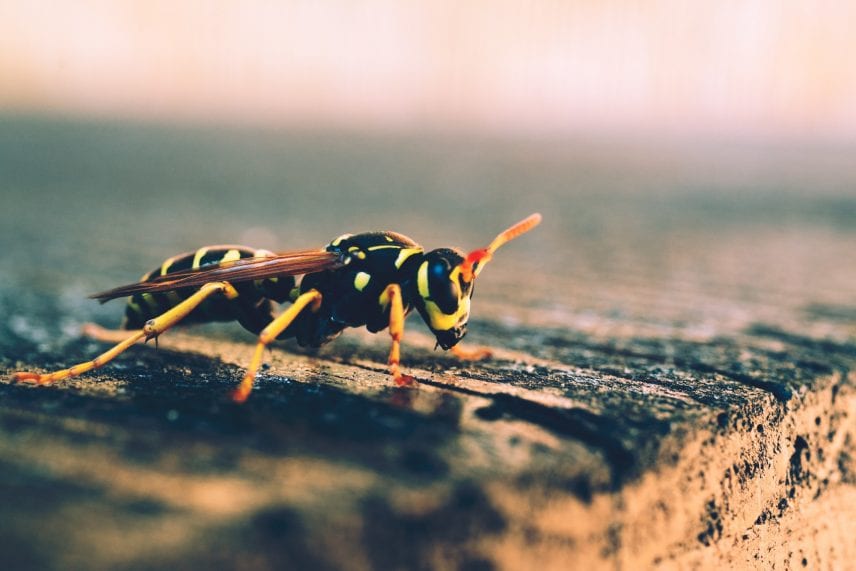It’s a beautiful summer evening. You’ve been barbequing a delicious meal, and the kids are playing peacefully in the backyard.
And then you hear it: the scream that can only mean one thing – someone has an insect sting.
You may be tempted to panic. You might not know what flying bugs that sting live in your area or how to treat their stings. How can you prepare your home to prevent future stings?
Fortunately, if you can identify the insect that stung you, treatment is usually a simple procedure. There are many guides for specific states that will help you name the insect.
The best way to ensure that you don’t get stung again is to remove an infestation and prepare your home with preventative measures against future infestations.
Identifying Flying Bugs That Sting
Insects can be hard to differentiate between and identify from afar, and no one wants to get close to them. But if you or a loved one has already been stung, you probably saw enough defining characteristics to tell them apart.
Most commonly, insect stings in Pennsylvania come from wasps. Multiple varieties of wasps build their homes in suburban areas, backyards, and even inside houses.
Though they are frequently mistaken for bees, wasps are much more aggressive and can sting multiple times in a row. Most bees have a fuzzy appearance to their abdomens while wasps have a shiny exoskeleton and a slimmer body.
Pennsylvania wasps include paper wasps, yellow jackets, bald-faced hornets, mud daubers, and cicada killers.
Paper wasps and yellow jackets have similar black and white patterns and body shapes, but paper wasps can be an inch long while yellow jackets are about .5 inches.
Hornets are mostly yellow with some black and white markings, and they range in size from .5 inches to .6 inches.
You may recognize mud daubers as very slim black insects with thread-like abdomens.
Cicada killers are the largest wasp you’re likely to encounter in Pennsylvania reaching 1.5 inches. They are mostly black with some yellow markings and orange tinted wings.
Here are some images to help you identify wasps that may be living in or near your home.
Some wasps can be differentiated by their nests. Paper wasps build nests that look like an upside-down umbrella made of paper-mache. Yellow jackets build their nests in small holes in the ground. Hornet nests are usually built in hidden locations like shrubs and bushes.
While they are less aggressive, certain varieties of bees will sting once (and then die) when threatened. Some of the stinging bees found in Pennsylvania are the sweat bees, honey bees, leafcutter bees, and carpenter bees which are often mistaken for harmless bumblebees.
It is important to know whether you were stung by a bee or a wasp as the treatment for each can be different.
How to Treat an Insect Sting
Once you know what insect stung you based on the bugs that sting in PA, you should start treating right away.
The typical symptoms of an insect sting are pain in the affected area, itching, swelling, warmth, redness, and hives. Symptoms of this nature can be easily treated at home.
If you were stung by a bee, there may still be a stinger in the skin. Using a flat, blunt object (such as a credit card) gently scrape the stinger out. Do not pull directly out as this can release more venom.
Once the stinger is removed or if you were stung by a wasp, wash and ice the affected area and elevate that limb to reduce swelling.
Itching can be relieved by applying a calamine lotion or a paste made of baking soda and water. Pain can be treated with acetaminophen and an antihistamine. More remedies can be employed if these are not working effectively.
If you experience severe symptoms such as coughing, nausea, a rash spreading over a large area of the body, dizziness, tightness of the throat, or breathing problems you may be experiencing an allergic reaction.
Allergic reactions should be taken very seriously and treated by a medical professional. Call 911 right away for IV antihistamines and breathing support.
Getting Rid of the Stinging Pests
You should never try to remove an infestation on your own. You may end up agitating the nest and receiving more stings than can be easily treated at home.
A pest control service can remove the nest of stinging pests without endangering you or your family.
Trained professionals with the proper protective gear can find and eliminate nests even if you aren’t sure where it is located. They will use a combination of liquids, aerosols, and/or dust to kill the current wasps, and then they will remove the remaining nest so that no future wasps try to inhabit it.
To prevent future infestations, consider cultivating plants that are repellent to wasps such as mint, citronella, and cucumbers. Ensure that you don’t leave food outside as many human foods are enticing to wasps. Most importantly, make sure that your garbage can lids are secure as the smell can bring wasps.
A Summer Safe From Stings
If you take preventative measures early on and call a pest control service at the first sign of infestation you can very easily get through a whole summer insect sting free.
But if you or a family member is stung it is important to know the flying bugs that sting in PA so that you can perform the proper treatment right away.
Already have an infestation? Fill out our form to get specialized care on your desired service date.


